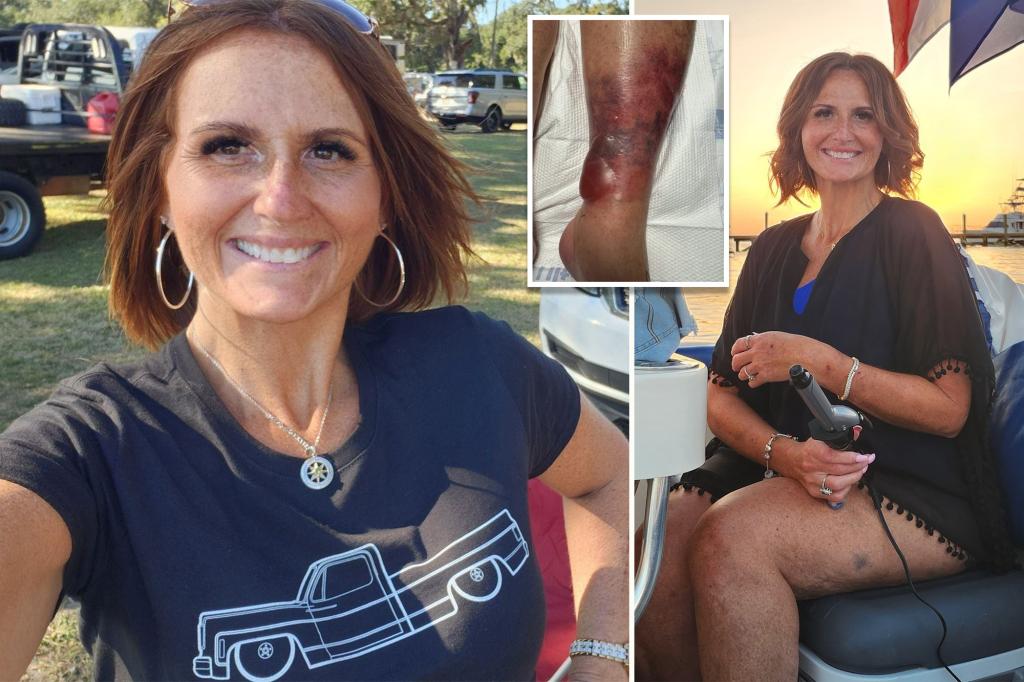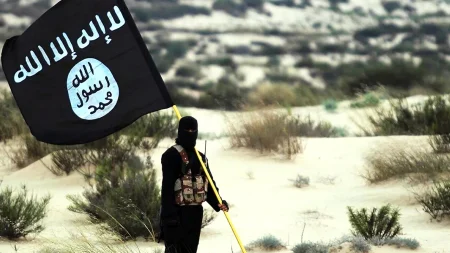A Mother’s Harrowing Battle with Flesh-Eating Bacteria After a Beach Swim
In a heart-wrenching tale of survival that serves as a stark reminder of nature’s hidden dangers, 49-year-old Genevieve Gallagher is fighting for her future after a seemingly innocent swim at Pensacola Beach turned into a life-threatening nightmare. What began as a joyful outing with her 7-year-old daughter Mila in late July at Santa Rosa Sound quickly evolved into a medical emergency that has left the Florida mother hospitalized, facing multiple surgeries and an uncertain recovery. Three days after her beach visit, Gallagher began experiencing alarming symptoms while at work – profuse sweating, general malaise, and most disturbingly, her leg began to swell dramatically and develop fluid-filled blisters. “I thought I had an infection, but never did I think I had a flesh-eating bacterium,” Gallagher told the Pensacola News Journal from her hospital bed. Hours after these symptoms appeared, she was rushed into emergency surgery, beginning a harrowing medical journey that would see her fight not only for her leg but for her life.
The culprit behind Gallagher’s condition was identified as Vibrio vulnificus, a naturally occurring bacteria that thrives in warm seawater. Medical professionals believe the pathogen entered her body through a small cut on her left leg – an entry point so insignificant that Gallagher hadn’t even considered it a concern when entering the water. The infection progressed with terrifying speed, requiring doctors to take drastic measures to prevent its spread. “There’s no antibiotics that they can give you to stop it. They just have to get out any infected skin and tissue. They’ve got to get it off your body,” Gallagher explained. This necessitated removing substantial amounts of tissue from her left leg below the knee, a procedure she described in vivid, sobering terms: “They debrided my leg down to the bare meat. They took most of the muscle, almost down to the bone, basically. It went up almost to my knee, so it’s a pretty large amount, and it’s all the way around my leg.” The photos of her condition reveal the devastating impact of the bacteria, with large areas of her leg covered in decaying flesh – a visual testament to the aggressive nature of Vibrio vulnificus.
The severity of Gallagher’s condition cannot be overstated. Shortly after arriving at the hospital, she went into septic shock, causing her organs to begin failing. While intubated and unconscious, her family received the devastating news that she might lose not only her leg but potentially her life. The emotional toll of this ordeal extended beyond her physical suffering, particularly when her young daughter visited her in the hospital. “Mila saw me in the hospital and said, ‘I wish this happened to me and not you,’ and I started crying,” Gallagher recalled with emotion. “That broke my heart. I was like ‘Mila, no, I’m so glad it didn’t happen to you. Your little body could not have taken all this that’s going on.'” This poignant moment highlights the ripple effects of such medical emergencies on families, especially young children witnessing a parent’s suffering. Despite the gravity of her condition, doctors at Sacred Heart Hospital were eventually able to stabilize Gallagher and, crucially, save her leg from amputation – though the road to recovery would prove long and arduous.
Currently receiving treatment at UF Health Shands Hospital in Gainesville, Gallagher’s recovery journey has been marked by complex surgical interventions and setbacks. One particularly challenging procedure involved removing muscle from her back to place over exposed bone in her leg – an operation that ultimately failed due to blood clots, necessitating additional surgery. The physical transformation of her leg has been profound, as has the accompanying pain. “Just looking at my leg, it doesn’t even look like my leg anymore,” she described. “It looks deformed right now. The pain is unbelievable. It feels like somebody took gasoline, poured it on my leg, and lit my leg on fire.” Beyond the physical agony, Gallagher has been candid about the psychological impact of her ordeal. “It’s been a lot on me and my family. My husband drives to Shands [hospital] every weekend and stays with me because my mental health has just been horrible,” she shared. “I’ve been strong through it all, but it’s been a lot mentally, emotionally and physically.” As a coordinator for a physician practice, Gallagher faces weeks more of hospitalization before she can even begin to contemplate returning to normal life.
Gallagher’s case, while severe, is not isolated. According to the Florida Department of Health, Vibrio vulnificus is naturally occurring in warm seawater environments. Though infections remain relatively rare, they can be devastating when they occur. The bacteria has been responsible for 23 reported infections and five deaths in Florida in 2025 alone, following 82 reported cases in 2024. Public health officials emphasize the importance of preventative measures, particularly warning swimmers against entering water with fresh cuts or scrapes – precisely the scenario that led to Gallagher’s infection. What makes cases like Gallagher’s particularly frightening is the speed with which the bacteria can spread and the limited treatment options once infection takes hold. Unlike many bacterial infections that can be controlled with antibiotics, flesh-eating bacteria require immediate surgical intervention to physically remove infected tissue before it can spread further.
Gallagher’s story serves as a powerful cautionary tale about the hidden dangers that can lurk in even the most beautiful natural settings. A day at the beach – something millions of people enjoy without incident – transformed her life in ways she could never have anticipated. Her willingness to share her experience publicly, despite its deeply personal nature, reflects a desire to raise awareness and potentially prevent others from suffering a similar fate. As she continues her lengthy recovery process, facing additional surgeries and extensive rehabilitation, Gallagher’s resilience in the face of overwhelming challenges stands as a testament to human endurance. Her battle with flesh-eating bacteria reminds us of both the fragility of health and the remarkable capacity of the human spirit to persevere through even the most daunting circumstances. For beachgoers everywhere, her experience underscores the importance of treating even minor cuts with caution when entering natural waters – a small precaution that could potentially prevent life-altering consequences.











